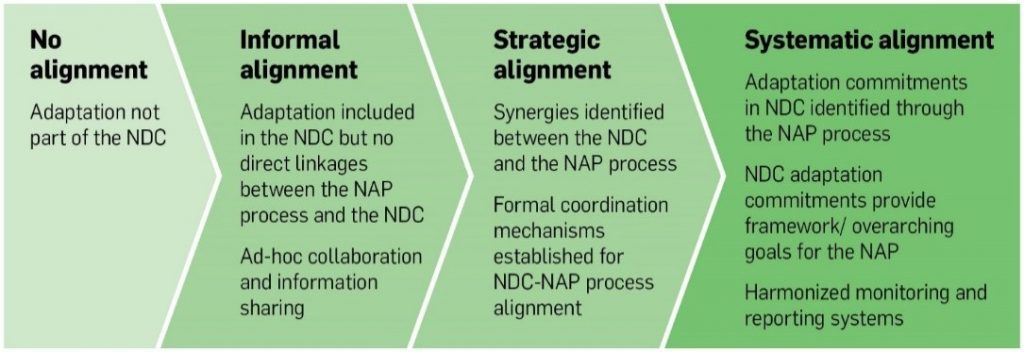
When it comes to adapting to climate change and achieving the goals of the Paris Agreement, nations around the world have access to a few useful processes to help them reach their goals—namely, their Nationally Determined Contributions (NDC) and National Adaptation Plan (NAP) processes.
In countries where adaptation information is included in NDCs, the two policy processes are interrelated. NDCs are a country’s pledge for meeting the goals of the Paris Agreement, including on adaptation, while the NAP process elaborates on how adaptation will be planned, implemented and monitored.
Why does 2020 matter?
Current NDCs are not ambitious enough to secure the Paris Agreement’s temperature goal of “well below 2°C.” In 2020, countries will have the opportunity to update and enhance the current climate commitments outlined in their NDCs. And there is good reason to do so: it presents an excellent opportunity to raise the ambitions of current NDCs in relation to both mitigation and adaptation.
Given that many countries included information on adaptation along with their mitigation commitments, they may also use this opportunity to update their adaptation-related commitments based on their NAP process. Alignment with the NAP process provides an additional opportunity to make the NDC more ambitious and valuable for implementation
How well are NAP and NDC processes aligned currently?
A recent analysis looked at synergies between NAP documents and adaptation-related information in the NDCs for all 12 countries that have submitted both documents to the UNFCCC’s official portals. It considered a spectrum of alignment, from no alignment all the way to systematic alignment.
What the analysis found was that countries are actively aiming for alignment of the two processes. More specifically, it revealed that:
- NAP processes are influencing the NDCs, as all 12 countries have a degree of alignment between the two processes. The countries with the most apparent attempts to align their NDC and NAP created concrete linkages by:
- Explicitly articulating the relationship of the NAP to the NDC
- Embedding shared visions and sets of priorities
- Setting out key institutional arrangements for coordination and joint action
- Setting up the NAP as an implementation vehicle for NDC adaptation goals.
- NDCs and NAPs can be complementary and mutually supportive because of differences in their level of detail and purpose. Where the NDC and NAP processes are strategically aligned, the detail provided in the NAP can clarify the basis for the adaptation priorities in NDCs while enabling the NDC to remain concise and focused on principles and high-level direction.
- NAP processes can serve important capacity-building functions. Both the process and the documentation of the NAP provide stakeholders with insights and skills that enable them to include adaptation considerations into their own plans and actions. It is an important basis for improving alignment and communication across levels of government.
- Monitoring and evaluation systems for adaptation are at an early stage. Some countries are planning to develop a dedicated system for the NAP, while others will use existing mechanisms and adjust these, as needed. For NDCs, the challenge is to gauge progress on adaptation-related information that they contain. For NAPs, the challenge is gauging progress on the capacity to address adaptation, as well as on reducing vulnerability. For both, an ultimate contribution to national development is important. It would be valuable at this early stage to consider the opportunities that an alignment of systems could yield in terms of improved efficiency and mutual learning for both NAP and NDC processes.
Can the NAP process be used to update and enhance NDCs?
2020 presents us with a real opportunity to communicate updated and enhanced NDCs and to strengthen the explicit relationship between NAPs and NDCs.
How can we make that happen? Here are three key actions that need to occur by then:
1. For countries that have not included an adaptation component in their NDC or that are planning to develop their adaptation contributions further in future years, the NAP process and its results could be used to inform the development of future NDCs. Vice versa, the vision for adaptation set out in the NDCs could guide the NAP process and use it as a framework for meeting the NDC’s adaptation commitment.
2. The NDC update could focus on improving the quality of the adaptation-related information by providing additional and new information. For example, the overall vision and priorities of the NAP can be summarized within the NDC, as appropriate. NAP teams could also prepare concise analytic inputs and proposals for consideration in the NDC update, highlighting institutional frameworks, risks and vulnerabilities, adaptation priorities and needs.
3. NAP teams could engage in a more dynamic way with the NDC update for submission by 2020. Efforts could focus on adding value and enhancing a country’s adaptation goal through the explicit recognition of the NAP process, its role in implementing the NDC and new commitments based on the NAP process and its results (following the first round of NDCs).
Any opinions stated in this blog post are those of the author and do not necessarily reflect the policies or opinions of the NAP Global Network, its funders, or Network participants.
